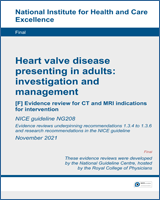From: Evidence review for CT and MRI indications for intervention

NCBI Bookshelf. A service of the National Library of Medicine, National Institutes of Health.
|
Risk factor and outcome (population) | Number of studies | Effect (95% CI) | Risk of bias | Imprecision | Indirectness | GRADE Quality |
|---|---|---|---|---|---|---|
|
Aortic valve area ≤1.2 cm2 compared to >1.2 cm2 on CT for predicting mortality under medical management Mean follow-up 3.2 years (AS patients undergoing CT and echocardiography in same episode of care, 45% with NYHA class III/IV, mean aortic valve area 0.94 cm2; mean age 76 years) | 1 (n=269) | Adjusted HR: 3.16 (1.60 to 6.26)a | Seriousb | None | None | MODERATE |
|
Aortic valve area ≤1.0 cm2 compared to >1.0 cm2 on CT for predicting mortality under medical management Mean follow-up 3.2 years (AS patients undergoing CT and echocardiography in same episode of care, 45% with NYHA class III/IV, mean aortic valve area 0.94 cm2; mean age 76 years) | 1 (n=269) | Adjusted HR: 1.43 (0.77 to 2.64)a | Seriousb | Seriousc | None | LOW |
Methods: multivariable analysis, adjusted for age-adjusted Charlson score index, sex, symptoms, mean gradient and LVEF (age prespecified in protocol was adjusted for but smoking was not)
Downgraded by 1 increment if the majority of the evidence was at high risk of bias, and downgraded by 2 increments if the majority of the evidence was at very high risk of bias
95% CI crosses null line
From: Evidence review for CT and MRI indications for intervention

NCBI Bookshelf. A service of the National Library of Medicine, National Institutes of Health.